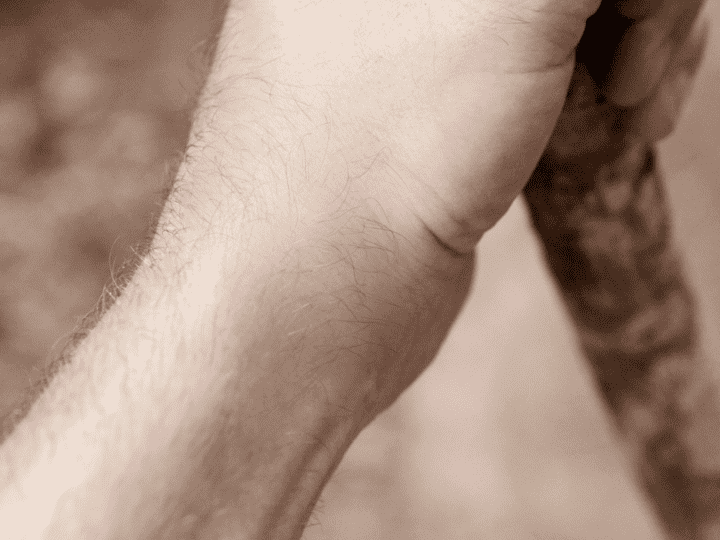Many avid hikers have found the benefits of a hiking stick along the trail.
Whether it helps in stabilization in loose terrain, helps in water crossings, or as an aid in inclement weather, hiking staffs are a helpful tool.
Using paracord to create a grip is a fantastic way to personalize your favorite hiking staff.
Table of Contents
How to Make a Paracord Hiking Staff Grip
To wrap your hiking staff with a paracord grip, start with a loop towards the top of the staff where you want your handle. Carefully loop the longer length of cord through the loop. Secondly, wrap the paracord around the shorter end of the loop, leaving roughly one to two inches of slack on the shorter end where you plan the grip will stop. Once you have tightly wrapped the handle to the desired length, knot the remaining slack with the one to two inches of the short end of the loop together. Cut off the excess and flame the ends of the paracord to avoid fraying.
Types of Paracord Grips
There exist many different ways you can create a paracord grip on your hiking staff. These different grips vary in how much cord is required and how complex the wrapping is.
I will detail several of the most popular paracord grips used for a hiking staff and the final products.
Common Whipping
Common whipping is the process I used in the bold section. This is the easiest and most common form of wrapping handles and staffs.
While the wrapping is simple, a few details need to be considered to complete this grip well.
It is crucial to ensure that the short end of the loop that you are wrapping the paracord around stays straight. Otherwise, the seam will be much more noticeable, and you will have a slanted lump running down your grip.
Also, it is essential to wrap it as tightly as possible. If you do not wrap your grip tight enough, it will go slack and create noticeable gaps between the paracord lines.
Ultimately, this is a very basic appearance that should have even rows of paracords wrapped around your staff.
Double Whipping
This type of grip for your walking staff is virtually the same as the common whipping, but instead of using one length of paracord, you use two lengths of paracord of differing sizes.
Now, the wrapping process is virtually the same, except that you use two lengths at once. When in the wrapping process, keeping the two cord lengths in the same position is essential.
If you do this correctly, the differently sized paracords will create a textured and alternate pattern that creates an incredibly satisfying grip.
If the two cords are different colors, it will have an alternating-colored handle on your hiking staff.
Again, keeping the slack that is being wrapped against the wood straight is vital to avoid the zig-zagging seam. Also, due to the two different cords being used, you now have two such slack pieces to keep track of.
It is also pivotal that you take care of the slack when tying the grip off. You must either knot the slack or burn the ends and then flatten the burnt parts with something flat to do this properly.
This will provide a good-looking and clean-looking grip on your favorite hiking staff.
Spiral Hitch
To make a spiral hitch grip on your walking staff, you must be adept at tying a clove hitch knot.
To tie a clove hitch, wrap your cord with a short end pointing down and underneath the staff. Next, wrap the working end around the staff and under the short end. Wrap the working end one more time and loop the working end between the loop and the staff.
You should have three distinct loops that can be cinched to tighten. As you tighten the clove-hitch, you will notice your short end gets cinched between two of the loops, and your working end is pointing out the opposite direction.
To form the grip, repeat the process of tying a clove hitch over and over while the wraps move up or down the handle to the desired length.
If you do this correctly, you will find that you will have a seam that spirals around the handle made from the overlapping portion of the knot.
To finish this grip, you can cut off the loose ends after the final knot, burn the ends to avoid fraying, and flatten the melted pieces to the staff.
West Country Whipping
This is a very simple weave that creates a sharp-looking grip on your staff. It is done by alternating a simple overhand knot (like the first step of tying your shoes) and then flipping the staff and doing the same thing on the other side to the desired length of the handle.
When making your overhand knot, it is crucial to do it the same way every single time so that the weave is uniform down the grip.
This means that when you make your overhand knot, there should be one piece pointing down and another piece pointing up. For example, the left end of the slack should always point down after the knot is made, and the right should always be in the upwards position.
As you continually make these knots, flip the staff, and then make the knot on the opposite side, you will find a seamless weave begins to form down the staff.
The final product should be a very crisp-looking weave. In the end, you can cut the slack and burn the ends when the grip is your desired length.
Frequently Asked Questions About Paracord Hiking Staff Grips
How much Paracord will I need for my grip?
It depends on the thickness of your staff, as well as the type of grip you want to weave. Expect to use at least three to five feet of paracord to create your grip.
Can I create a loop for hanging my staff on my wrist or a hook?
To create a loop, it is important to leave some slack at the top and bottom of your grip that you can knot together. These ends can be used to create the loop rather than cutting and burning the ends of the grip.
Conclusion
If you are an avid hiker and would love to have a distinguished and personalized hiking staff, then try some of these paracord grips.
These grips can be customized with a helpful loop or specific colors to make your hiking staff just the way you like it.

